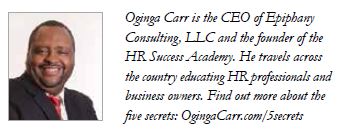5 Secrets to Success as an HR Department of One
 When I am traveling the country working with my clients and teaching classes on HR, I always get questions on what are the most important things to remember as an ‘HR Department of One.’
When I am traveling the country working with my clients and teaching classes on HR, I always get questions on what are the most important things to remember as an ‘HR Department of One.’
I relate to that feeling because I was in corporate America as a manager, and the organization that I worked with changed to what they called a ‘small-business concept.’ That meant we would have to start taking care of our own HR responsibilities within each of our own offices, and my position changed from being a manager to the manager/ HR/payroll/janitor/babysitter/etc. So I understand what it’s like to run your own business and be faced by the many compliance issues. If you don’t stay on top of it, legal compliance can be difficult and costly. I want to break down for you the ‘5 secrets to success as an HR Department of One.’
1. UNDERSTAND EMPLOYEES VS. CONTRACTORS
One of the big tripping points for small- to medium-sized businesses is in classifying workers. In order for a worker to be a contractor, they have to be able to pass a three-prong test called the ‘ABC’ test.
The A portion of the test signifies control or direction of the work. If you tell a worker when to show up, when to take a break, how much you are going to pay them, etc., then they are probably an employee. (See box on next page for further clarification of employee vs. contractor.)
The B portion of the test refers to whether or not the service is outside your usual business or usual location of business. For example, if you contract with a plumber to do some work in a bathroom before you paint, that would be an outside service.
The C portion test declares independent business or trade. Does your worker have their own workers’ compensation insurance or a waiver? Do they have their own business license? You would need to answer yes to those questions to be able to safely answer yes to portion C.
In general, for a worker to be considered a contractor, they must pass all three of these tests and you must be able to prove it. Some states only require the worker to pass two of the three, but every state has requirements. If the worker does not pass the ABC test, then they are an employee, which means they must meet all of the standards and requirements of an employee. The fines for misclassification can be hefty.
2. UNDERSTAND EXEMPT VS. NONEXEMPT
Once you classify a worker as an employee, you then must classify what type of employee they are. You have two options: exempt or nonexempt. Nonexempt employees must be paid overtime if they work more than 40 hours in a seven-day work week. Exempt employees do not have to be paid overtime, but have to pass specific tests in order to be exempt. The two tests are the salary basis test and the duties test. They must both be passed in order for the employee to be exempt. You should indicate exempt or nonexempt in the job description. It is a great idea to review your employees’ status with an employment attorney or an HR consultant to make sure that your organization is abiding by these regulations.
3. UNDERSTAND RECORD RETENTION
Keeping the records of your employees can be confusing. For most businesses that do not have direct governmental oversight, a simple process will keep you compliant. Keep personnel files seven years after termination. Examples of personnel information would be handbook acknowledgement pages, employee discipline, employee reviews, and general employee information. You also need to keep medical files six years after termination. Medical files would include doctor’s notes, reasonable accommodations, drug test results, workers’ compensation cases, and anything that speaks to your employees’ medical history.
Medical files must be kept at the ‘level of negligence.’ For paper files, this means in a locked room and in a locked file cabinet. Medical files must also be kept separate and distinct from personnel files. This means in a separate file drawer than the personnel file, if you are keeping them as paper files. It is also vital to remember that sensitive information must be kept in a locked room, in a locked file cabinet, or in a password-protected folder if it is kept electronically. Sensitive information would be any information that includes identifying information on your employee like social security numbers or driver’s license numbers.
4. KNOW THE POLICIES AND PROCEDURES OF YOUR ORGANIZATION
As someone with HR responsibilities, it is vital to know the handbook for your organization. You have to be able to coach and counsel employees when there is a handbook issue. You have to be able to recognize when a handbook issue is unfair to your employees and take steps to adjust the policy. Remember, you can make any policy you’d like in your organization as long as it is legal and applied evenly. This means that your policies can be as strict or as lenient as you would like; they just have to be consistent. When policies are consistent, the same type of employees have the same rules.
5. UNDERSTAND THE IMPORTANCE OF JOB DESCRIPTIONS
Many times, we can trace productivity issues in organizations to a lack of clarity in job descriptions. If you do not describe the employee’s job fully, it doesn’t protect you legally or help your productivity. How can you expect your employee to do their job if they don’t fully know what their job is? You must be clear in your explanation of job responsibilities. A clear job description would include every recurring duty that your employee would have. This means your description could be 1, 2, maybe even 5 pages. But this would allow for your employee to truly understand what is expected from them in the position. By being clear in the job description, it will help you in the hiring process. You can hire more employees that are capable of doing the job and have an understanding of what is expected.
Follow these 5 simple steps and you will start to really control the HR in your organization, and create a company that functions much better and produces more. At my company, we believe in productivity through structure. The better organized we are, the more productive and profitable we can be!
________________________________________________________________________________________________
EMPLOYEE VS CONTRACTOR TRAP
Here is the most common issue that bites business owners as it relates to making someone a contractor: A worker does a duty for you for one year. You have told them when to show up, when to take breaks, and directed them in their duties. You have told them that they are a contractor and are paying them on a 1099 basis. After a year, you get angry at them for a mistake they make on a project and fire them. The worker goes to unemployment and files for benefits. Unemployment will contact you and ask if the worker was an employee. When you claim they are a contractor, they would ask for you to prove how the worker passed the ABC test. Since you controlled the duties of the worker, it could be ruled the worker was an employee and is subject to unemployment benefits, as well as you being charged heavy fines to your business.
_______________________________________________________________________________________________





